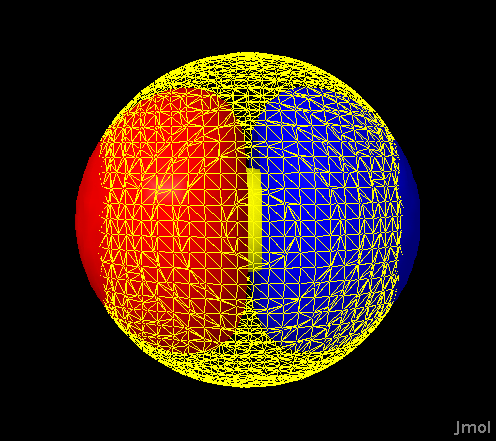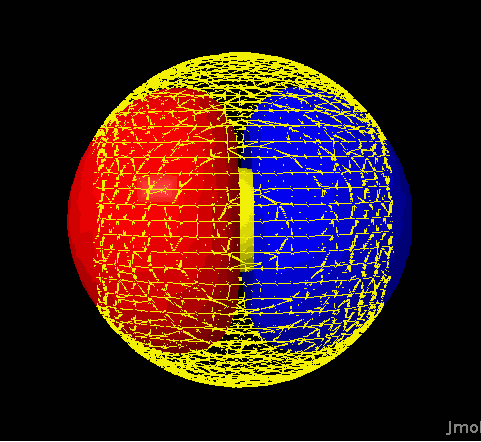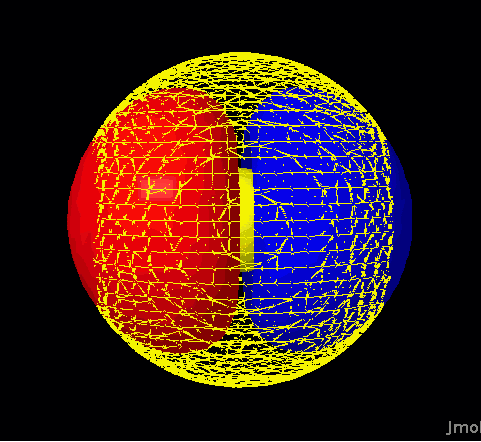Hybrid orbitals are the result of a model which combines
atomic orbitals on a single atom in ways
that lead to a new set of orbitals that have geometries
appropariate to form bonds in the directions predicted by the VSEPR
model. The
VSEPR
model predicts geometries that are very close to those seen in real
molecules. There are many descriptions of hybrid orbitals
available. See any general or organic chemistry text. A web search will provide
additional descriptions.
First, let us see the problem with the normal s and p orbitals on an
atom. Consider methane (CH
4), which consists of a
carbon atom with four hydrogens arranged in a tetrahedral geometry
around the cental atom. In its ground state (lowest energy)
configuration the carbon atom has an electronic configuration of [He]2s
22p
2.
This means that the valence electrons (the ones involved in bonding)
occupy s and p orbitals. In the figure below the 2s and the three
2p orbitals are shown superimposed on a methane molecule. Notice
that none of the orbitals point towards the hydrogens! If we were
to rotate the orbitals we would find that at most one p orbital could
point towards a hydrogen at any given time.
Figure 1: A methane molecule with
the carbon s and p orbitals shown. Note that these orbitals do
not point along the C-H bonds. Each of the p orbitals points along the
X, Y or Z axis.
You may click on each of these four images to enlarge them. Use
your back button to return here.
To view live images of the unhybridized atomic orbitals you can go to
Dr. Gutow's atomic orbital
page. To compare with hybrid orbitals use these links for
sp,
sp2
and
sp3 hybrids.
This means these orbitals as we usually visualize them cannot take part
in the bonding. The solution is to combine these orbitals (add
and subtract them from each other) to get four orbitals pointing in the
proper direction. To get four new orbitals we have to combine
four atomic orbitals. Thus the orbitals that point the correct
directions are made by combining the 2s and all three of the 2p
orbitals. This kind of hybrid is called an
sp3 hybrid orbital and is the
kind of hybridization seen in molecules of
tetrahedral
geometry.
How the atomic orbitals are combined to give sp
3
orbitals is a bit complicated, so we will consider the simpler case of
the sp hybrid formed from combining a single s and p orbital.
This hybridization is what is seen for carbon in
linear
molecules like CO
2 and acetylene (C
2H
2).
To form separate bonds pointing 180 degrees away from each other two
separate orbitals pointing in opposite directions are needed.
These are formed by combining the spherically symmetric s orbital with
one of the p orbitals. The p orbital by itself doesn't work
because both lobes are part of the same orbital, so can only
accommodate one pair of electrons. In two bonds there are two
pairs of electrons to accommodate.
In this example we will combine the 2s orbital with the 2p
x
orbital. Since we start with two atomic orbitals we will get two
atomic orbitals. The two combinations are 2s + 2p
x and
2s - 2p
x. Consider the + combination. Since the
two lobes of the p orbital have opposite signs the positive lobe (+)
adds to the s orbital and increases the electron density on that side
of the atom. The negative lobe (-) subtracts from the s orbital
and decreases the electron density on the other side of the atom.
Since the orbitals represent electron waves the sign actually
represents the phase of the waves and addition is constructive
interference while subtraction is destructive interference. The -
combination causes enhancement of the electron density on the opposite
side from the + combination. This is illustrated in the graphic
below.

|
+ case:  |
- case:  |
|
sp+:  |
sp-:  |
|
Figure 2: The left image is of
both the 2s and the 2p x
orbital on a single atom. The sphere in the middle represents the
location of the nucleus, much enlarged so that you can see it.
The yellow mesh represents the 2s
orbital with positive phase,
the solid blue surface one lobe (positive) of the 2p and the red
surface
the other lobe (negative) of the 2p. The middle animations show
how
the +
(top) and - (bottom) combinations yield two orbitals pointing opposite
directions.
The images at right show the two sp orbitals (sp + and sp -).
To manipulate these orbitals and compare them directly with the other 2p y
and 2p z orbitals that did not get used in making the
hybrids see the interactive sp hybrid page. |
The other hybrids use more complicated sums (not just 50:50
combinations) of the orbitals that are combined to yield the
appropriate hybrid orbitals. You can determine the hybridization
of an atom from the VSEPR geometry about that atom. Notice that
the sum of the exponents is the same as the number of groups about the
atom. This is also the same as the total number of hybrid
orbitals you get. The
relationship is shown in the table below.
Table 1: Relationship of the
VSEPR
geometries to atomic hybridization.
Number of
Groups around the atom
|
Sub-Shapes
A = central atom
X = atom attached to central atom
E = nonbonding electron group on central atom
|
Hybridization
|
2
|
AX2, Linear |
sp
|
3
|
AX3, Trigonal Planar
AX2E, Bent |
sp2
|
4
|
AX4, Tetrahedral
AX3E, Trigonal Pyramidal
AX2E2, Bent |
sp3
|
5
|
AX5, Trigonal
Bipyramidal
AX4E, See-Saw
AX3E2, T-Shaped
AX2E3Linear |
sp3d
|
6
|
AX6, Octahedral
AX5E, Square Pyramidal
AX4E2,
Square Planar |
sp3d2
|


